Interviewed in Zagreb Octobor 24th 2008
During the past twenty years, the architectural team of Annette Gigon and Mike Guyer has managed to win an outstanding and firm position among the pleiad of architects coming from the Swiss German region, some of whom are at the very top of contemporary architecture. Although their work is free of any rhetoric or narration, they refuse to be described as minimalists. In the design process, they do not accept an a priori decision on the form because every project of theirs is defined by specific parameters whose analysis brings them to making the decision on the materiality and morphology of a particular object. Contextuality is also an important factor in the works of Gigon-Guyer; however, this does not concern the material, but the cultural, mental and temporal context. Their contribution to contemporary museum architecture is especially important, in the sense of their lack of extravagance and because of the clearly defined topic.
ORIS: When we talk about the phenomenon of new Swiss architecture, we need to say that since the 1980s, the works of architects like Peter Zumthor, Herzog & de Meuron, Gigon-Guyer, Diener & Diener, Bearth & Deplazes, Morger & Degelo have come into the focus of interest, partially even at a global level. Can you tell us something about the foundations, background and reasons for this phenomenon, not to mention the fact that le Corbusier was also Swiss. How do you see your position as a protagonist of this phenomenon?
Gigon: We entered the scene in 1984 when we graduated. I started my studies in 1979 with no previous experience in architecture, I didn’t come from a family of architects. But to be precise, there were interesting Swiss architects even before the 1980s. There were many different views within the Tendenza in the late 1970s and early 1980s – Reichlin, Reinhard, Snozzi and Botta, who was well known even beyond Swiss borders.
ORIS: That was the very introduction to Postmodernism.
Gigon: Yes and no. Bruno Reichlin and Fabio Reinhard gave very interesting contributions in the sense of Postmodernism, but Botta, Vacchini and Snozzi as well cannot simply be subsumed under the term ‘Postmodernism’. They were all, and still are, interesting architects.
ORIS: Olgiati senior was also important.
Gigon: I wasn’t very much familiar with his works at the time, I was fascinated by some other people, but to my colleagues like Peter Märkli, whom I appreciate, Olgiati senior was of great importance – his position between modernism and traditional houses of the Graubünden region.
I actually wanted to say that there were a lot of interesting Swiss architects between le Corbusier and the ones I previously mentioned. Even before we had the phenomenon of Max Bill, then the people who represented the Neues Bauen (New Building) – Alfred Roth and Häfeli, Moser, Steiger and many others. But at the moment when I started my studies, I was fascinated by Louis Kahn and Swiss architects like Botta and Snozzi, and then, relatively early on, I found about Herzog & de Meuron. Somewhere halfway through my studies, I read an article by Martin Steinmann about their first building, the Blue House. At the time I was preparing a paper on materials and their alienation for my seminar, so I visited both these architects in Basel, probably in 1982. I was fascinated with their conceptual, almost artistic attitude.
But your question concerned the phenomenon of Swiss architecture and its background, why Swiss architecture is so strong today. I see several explanations, the first one of course being that talented, ambitious people embraced this calling. The second reason is that there is interesting, intelligent architectural criticism in Switzerland. In the beginning there was Martin Steinmann, who at the time was writing for Archithese magazine. Another thing I also find important is that in 1984 or 1985, the Swiss daily newspapers started publishing articles about architecture. This trend was started by Loderer, who worked as a journalist for Tagesanzeiger. He walked around town telling good from bad quality. He introduced some sort of a critical discourse in the daily press. This was accepted by the Neue Zürcher Zeitung, and they too started writing about architecture and report about it, as they already had about theatre, film or literature, in a feuilletonistic, well-informed, but also benevolent way. The quality of reporting in the media was truly important in perceiving architecture as a branch of art, largely exposed to the public.
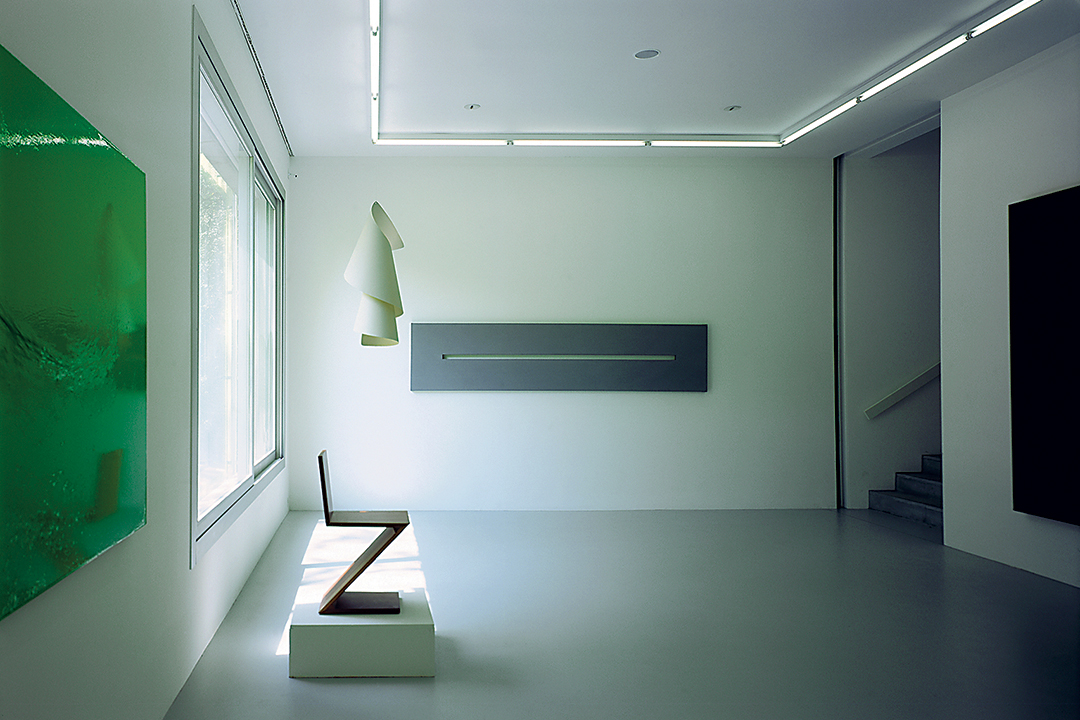
I think there is a third reason as well. Namely, craftsmanship in Switzerland has been of a very good quality for a long time. In Switzerland, intelligent people choose not only academic careers, they become craftsmen as well.
And there is perhaps a fourth reason: the legislation concerning execution and building permissions is not overburdened by rules, as is sometimes the case in other countries. The space for manoeuvre is large enough, so it is possible to develop new, quality solutions together with the craftsmen.
ORIS: Theoreticians and of course critics, who have the need and perhaps the obligation to set some sort of guidelines in this wide area of art, have positioned you as well. For example, Wilfried Wang labelled your work as ‘variegated minimalism’. Can you accept that, do you have any doubts in that regard?
Gigon: Wang added ‘variegated’ to the term minimalism, meaning multiple, multi-coloured. Variegated Minimalism is in fact a contradiction, a paradox. What he said is that we are actually not minimalists. The categorization method is not appropriate for understanding our projects. I am not interested in totally perfect buildings that are precise to the millimetre, nor in reduced, minimalist buildings. Quite the contrary: for each project we have a conceptual attitude that is always different, and that makes it additionally complicated if you want to write and categorize from the perspective of art history, but for us it’s a potential danger of falling between two stools. It’s our risk.
ORIS: Many of your most important projects are museums, places where things are collected, preserved, researched, exhibited and mediated. Museum architecture, just like art, has undergone major changes in the past hundred years. Development in the sense of finding as neutral spaces as possible that are adjusted to the ever greater dimensions of exhibits, are contrary to buildings that establish an identity and demand attention, as is required by the art industry. On the one hand, we have this spectacular museum architecture, and on the other hand the questioning of neutral spaces that adapt well to art exhibits. How would you state your own position when you design a museum?
Gigon: This range from restrained museum buildings to intrusive, loud, egocentric architecture existed before, it is not a modern phenomenon. If we look back at the discussions about, for example, the Viennese Art History Museum [Kunsthistorisches Museum] we can establish that even then there were discussions about whether the museum had too much ornament and whether it was too extravagant for art exhibitions. The conclusion then was: ‘No, if you want the artistic treasures to give their best, it is necessary to have the best and richest artistic craftsmanship, the most lavish frame.’ This was aristocratic museum architecture with adequate means. Soon after that, the museum movement appeared, originating in artistic associations. These were bourgeois circles that wanted to build places, spaces and buildings for staging exhibitions. Their financial assets were limited, this was most of all about creating cultural spaces. These are far more restrained examples, like Billing’s Kunsthalle in Baden-Baden, or the Kunsthalle in Basel. We should also mention Alfred Lichtwark, director of a museum in Hamburg, who was a significant figure at the turn of the 20th century. Therefore, in that sense, the discussion has lasted for more than a hundred years.
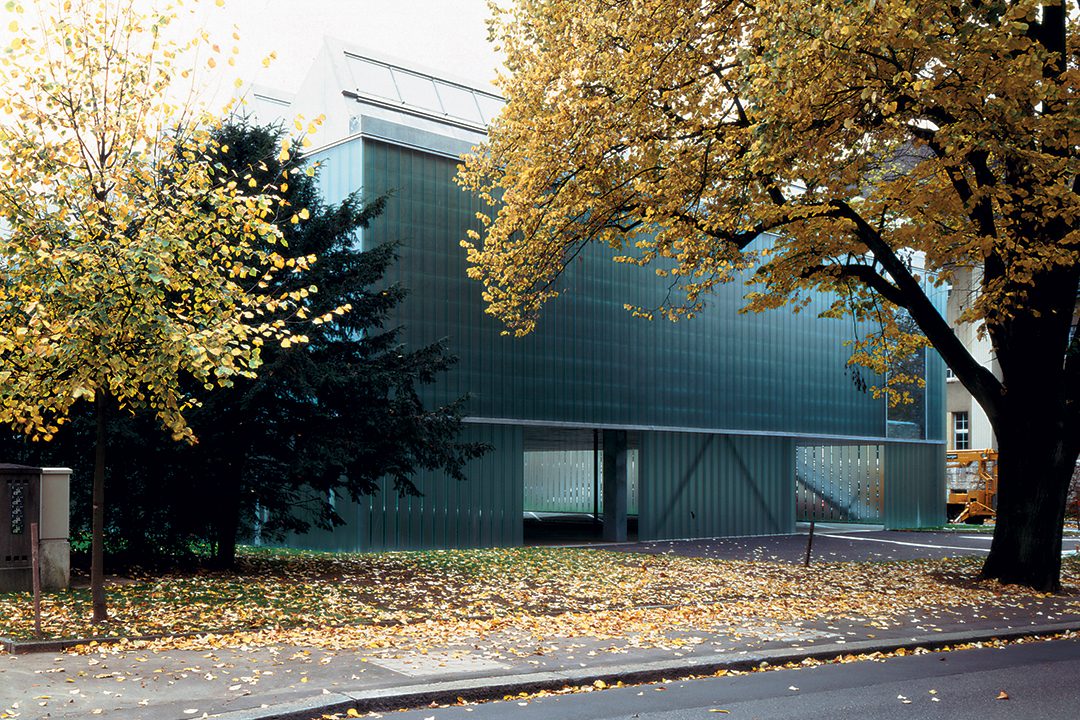
From the time of our Kirchner Museum in Davos we seriously and intensively dealt with the issue of how to build a museum. We intend to give preference to the perception of a work of art for every museum. We still think that our museum spaces are simply not ‘neutral’. They definitely have their own identity, specific character and are very much different from each other. Museum buildings also have a strong appearance from the outside, simply showing their function. For example, the Kirchner Museum shows with its glass membrane the way light reaches the interior. The form of the Liner Museum shows how it gets its light (like a turbine), the art museum in Winterthur gets its light through simple industrial shed roof lights because the budget here was modest. This also goes for the Mouans-Sartoux museum, the only one where the light comes from the side, i.e. ‘normal’ windows are the source of light, besides, it is the only museum of such an intensive colour.
ORIS: It is interesting that it was actually in Mouans-Sartoux that you designed the public space as semi-private. How did this mixing of various areas come about?
Gigon: It’s a nice story. Immediately after the Kirchner Museum was built, we were invited to an interview with the artist Gottfried Honegger. The competition for Mouans-Sartoux, where he and his wife Sybil Albers appeared as investors, was only opened a few years later. He told us: ‘Look, these exhibition spaces you built in the Kirchner Museum are nice, beautiful, but to me they are too sublime, too “divine”, or in other words, insufficiently human.’ He told us that he had recently acquired a small castle in Mouans-Sartoux for temporary exhibitions. The dimensions of the simple living quarters in the castle were quite small, but his experience had shown that actual art in it stands out excellently, even large exhibits look good. He actually does not like the museum light from above, because it negates the relationship with the environment. Honegger talked about how he wanted some sort of everyday life for the exhibition spaces, so visitors could get the idea about how to live with art. For him, art does not just belong in museums, but should primarily be with people in their homes. We tried to give form to his point of view, to this notion of exhibiting works of art. We tried to translate this into architecture when we won the competition eight years later for the Mouans-Sartoux museum besides the mentioned small castle. Since the site was wooded and steep, we designed a very small floor plan in order to preserve as many trees as possible. Therefore, we developed a tower shaped like a tree, with relatively small rooms. The museum has several interesting works of art, that truly enter into the relation with side light and mirroring of windows, such are works of, for example, Adrian Schiess. Schiess is interested in that interference, linking of life and art.
Honegger even accepted the sunlight on the exhibits. I will quote one of his striking sentences in this regard: he wants art to ‘live’ in the ‘right’, everyday light, therefore, he would be prepared to accept the possibility for it to ‘die’ one day, in other words, become damaged. Therefore, that’s the reason why in the case of the collection of Sybila Albers and Gottfried Honegger, we tried to make something completely different and to take a few shortcomings into account. The side light meant the loss of an exhibition wall, there’s mirroring, not all sides are equally well lit. All these factors that the museum curators absolutely want and have to avoid, are present there on purpose.
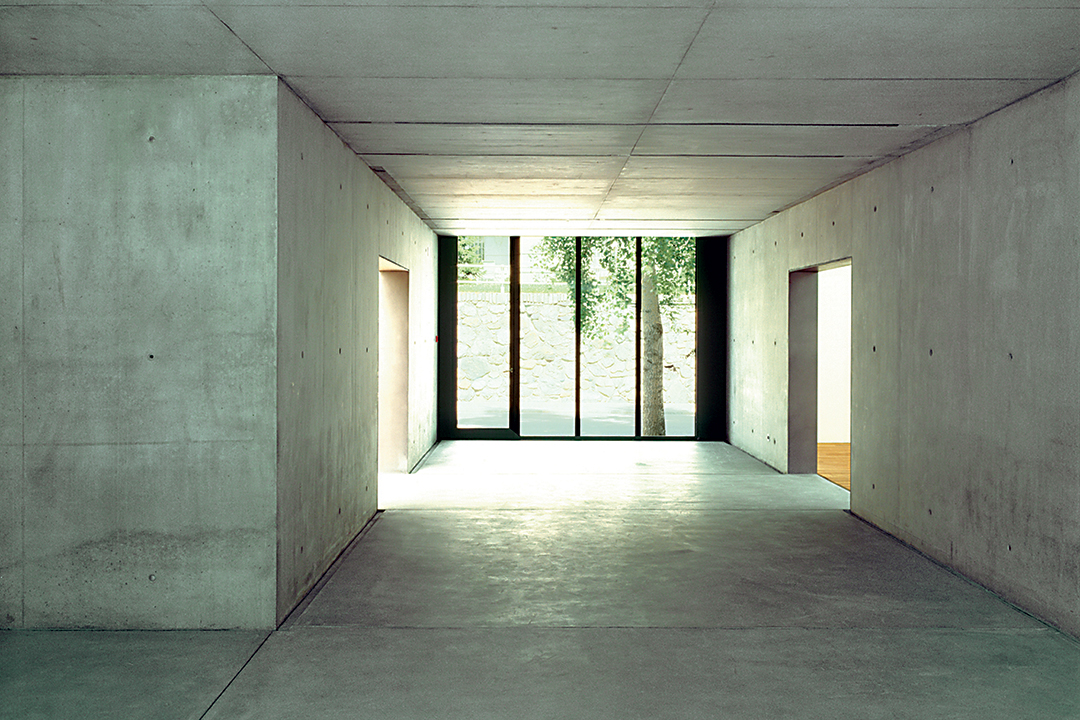
ORIS: Let us return to the Kirchner Museum, the communications zone there is in extreme contrast with the exhibition spaces, it is so dark that you can actually see only the landscape that suddenly becomes visible like a painting. This was the landscape that the artist, expressionist Ludwig Kirchner, lived in. We’d like to know how this concept was created, also related to the context of Davos, to its urban structure.
Gigon: There are several references here and a few parameters, but the most important thing is that Davos has a regulation concerning flat roofs from the 1930s, thanks to architect Rudolf Gaberel. He had a vision of Davos being a modern mountain town. The conglomerate of cubes to some extent truly repeats the structure of Davos as a settlement. But at the same time it simply depicts a programme that anticipated four exhibition rooms of approximately 200 square metres – four times more space than the existing provisional exhibition space of Kirchner’s works in the post office building. The next factor was the skylight design; we wanted them to be independent of the snow. This meant that the snow would still cover the roofs, but without obstructing the transmission of light. Therefore, it was necessary to bring the light to the skylights only from the side, that’s why there had to have a space between them, which again led to the exhibition spaces not being placed one next to the other, but always organized so that they would have a space between them. In terms of lighting, this was an ideal situation for each of the rooms. This interspace that separates the exhibition rooms, this internal street you follow, observing Davos in which Kirchner worked and lived, this space was interesting to us. From there, you can look at the pine trees outside in the landscape, and then see those pine trees again in Kirchner’s paintings. The lobby has an attractive quality to it because you can look into the museum from the street. It is not necessary for the museum to be hermetic, elitist.
Such a layout gave us the opportunity to instrumentalize that landscape and still succeed in making concentrated exhibition spaces that are all about art.
ORIS: The Kirchner Museum shows the uniform materials used in this building, something that is characteristic of your work. On the roof we also have glass, shards of glass. Only the foundation is made of concrete, everything else is made of glass, but the concrete mass also has the ingredients of glass, with chemical ingredients like quartz, silicon carbide. Does this uniformity actually improve the strength of the interior idea of the building? To what extent can visitors and observers perceive this?
One more question, in this museum you used glass as a cloak, a protection against the elements. The concrete surfaces in the Oscar Reinhart museum in Winthertur’s Römerholz were pre-patinated with copper. What is important to you when it comes to materials? Does the materialization concept change during the design process or is it clear from the beginning?
Gigon: In the Kirchner Museum we largely wanted to show how it was built, how the structure of the façade was made, and that the construction was mostly made of concrete. That was the reason for the bare communication hall between exhibition spaces. Contrary to this, the exhibition rooms are panelled. That was the way to show how the building was ‘made’ inside and outside, hence the glass membrane. Actually, glass is a material par excellence suitable for museums, it enables a good view of the exhibition’s objects, and still protects the building. Glass enabled us to show the building’s wall structure. We sanded the glass, and depending on the viewing angle, we can see the aired thermal insulation.
Sanded glass makes the light from the skylight appear diffuse – like a cloud. With the help of additional mobile lamellas we got uniform lighting on all four walls of the exhibition room.
This was also the time when Switzerland started recycling glass. First we had a simple notion that we could use shards of colour-free bottles, like those for Coca-Cola or wine. Then we also realized that old construction glass was also being collected. We knew that glass has the same specific weight as stone – therefore it allowed us to use it as a replacement for gravel for the roof loading. The entire building had some sort of crystal appearance to it. And the theme of glass in the mountains indeed reminds one of Bruno Taut and Paul Scherbart, or earlier of Paxton’s Crystal Palace. The sanded sliding doors in the health resort in Davos also come to mind. And then there was this extraordinary act of taking something we don’t like and turning it into something beautiful, thanks to the different way of using it.
.jpg)
ORIS: This moment of irritation, not the smooth but also the rough and unexpected, perhaps the boldness of doing something that is not pretty, is what makes your work poetic.
Gigon: Probably, yes. It is simply this which becomes truly interesting.
ORIS: Let us return to the museum buildings in Winterthur, they’re both extensions of existing museums, somewhat different, but there is also a certain degree of togetherness. Buildings speak with their own language. What is your communication with the existing, historical buildings?
Gigon: In Römerholz we had the unusual attempt to use substitute buildings to adapt the historic building from 1914 with its extension from 1925 – to resemble them, but not with the help of detail and form, but in a completely different way. Since the villa was built in the style of French Renaissance summer resort houses, and truly looks like it is far older, we also wanted to give the new building a ‘false’ age. We considered using copper, a material that quickly changes from new to old, and even visually changes its character. It is possible to speed this up, something that is always done with false antiques, by processing them with chemicals or burying them in dunghills. We found copper powder in a toy store and treated the concrete samples with it, and then observed how it changed under the influence of the elements. At the same time, we tested the limestone to see how it reacts with copper and whether it turns into a skin-like colour, like the nude paintings in the collection. However, the results were not at all convincing. But then, we discovered that one of those samples that was lying upside down on the floor for a longer period of time turned almost completely green. This was the combination we decided to go with. In the end, the mixture of concrete was like a ‘magic potion’ – with crushed ‘additives’ that were already prominent in the villa – limestone and copper. The plates turned green really soon after we treated them. Besides, we made the roof out of copper plates, and in the rain, the water pours down from it onto the façade, and the copper particles sediment on it. After ten years, we have now also some sort of a ‘rain drawing’ there – a watercolour painting that becomes ever more pronounced – like bronze sculpture pediments.
The situation was completely different with the other museum in Winterthur. After the unsuccessful referendum regarding the big extension building, the artistic association issued the competition for a financially more suitable and makeshift extension of the museum building, and we won. We only made contact with the historic building in a single spot, in order to have as few costly interventions as possible. We constructed this 1000 square metres of museum space as a financially affordable industrial building, but nevertheless, in the inside we designed it so that the rooms have nothing provisional. On the outside, we applied an affordable industrial glass envelope, and in the same way we also closed the parking space on the ground floor, that had to be retained. If we had more money available, of course we would have placed parking in the basement, so it would have been possible to build a bigger volume. But despite these unusual requests, and exactly because of these requests, we still ended up with a very interesting building.
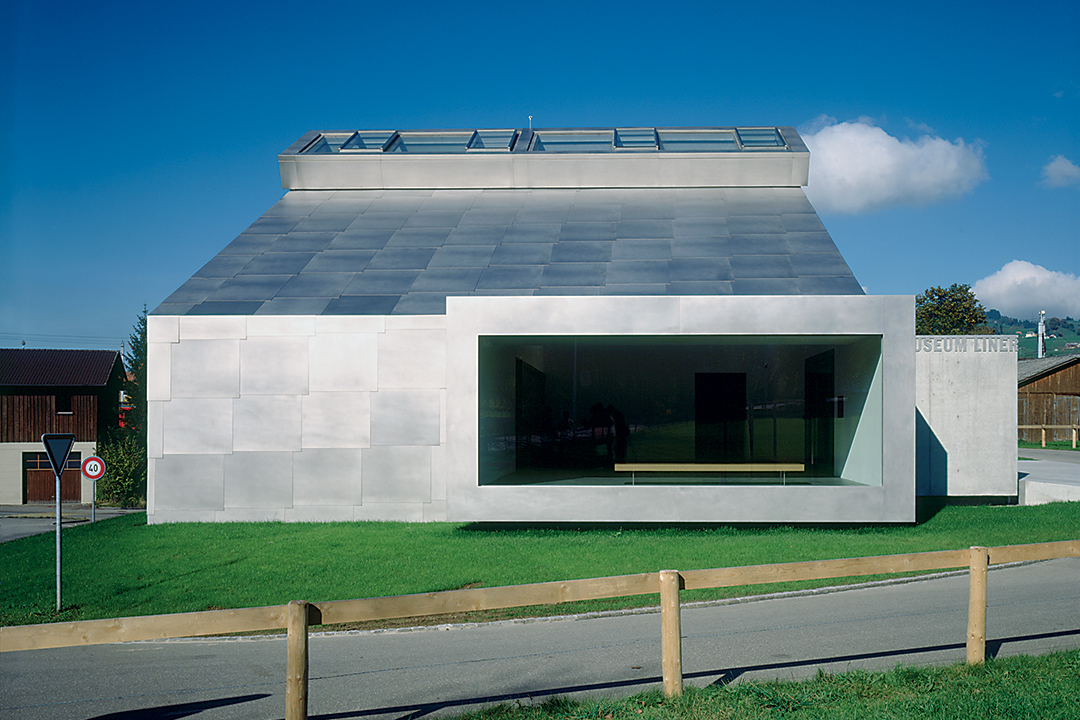
ORIS: If we compare the Kirchner Museum and Liner Museum in Appenzell, is this one a big leap forward in your opus or just further development, from a group of boxes to an expressive sculptural creation, in a certain sense to a second nature? Or was it just seeking an optimum solution for particular contents and landscapes during the consequent and continuous work, as is the case in Appenzell?
Gigon: The latter of course. It is a case of an individual ‘development’ far more than ‘further development’, but the complete experience is certainly not lost. Appenzell is placed peripherally, no one will come there simply by chance. We therefore imagined that the visitor will find himself there alone with the art, but that he shouldn’t feel lost in there. This motivated us to make small rooms – even before the Mouans-Sartoux project. Rooms that enable closeness with the works of art. The sculpture character of the building comes from each room having its own gable, that they are changing from bigger to smaller scale, but also because they are sheathed in only one material. The museum can be seen as an industrial building on the edge of Appenzell, we can also interpret it as a series of houses with slanted roofs that you can find in the village core of Appenzell, or as a connection with the pointy hills of the surrounding landscape.
ORIS: We could ask you a question about your origins. Today form is a starting point for many people, many of whom are successful. Sometimes it is arbitrary, self-satisfying. But in your origins it is probably about the intertwining of different and complex relations that stand at the beginning of a project – the relationship to the investor, the landscape, the material etc. Form may not be of primary value.
Gigon: The starting point is both the form and also the place and of course the spatial programme. Of course, there are situations in which form is simply given. We are often tied in a formal sense due to the understandable wishes of investors in regard to maximum degree of usage, to the adherence to building regulations that are most restricting. But to us, the programme is definitely a starting point more than the form. We are looking for form by help of programme and space.
ORIS: One more question regarding materiality that is linked with the notion of physical presence of architecture. Your projects indicate architectural notions, linked with space and spatial experiences. Therefore, you accentuate architecture’s physical character, together with an interest in construction, materiality, structure. Is the physical appearance truly the central aspect of architecture for you?
If I may quote you: We work with materials like a painter works with colours?
Gigon: Yes, I’d almost say those words again! We can’t have architecture without materiality and it is fundamental how the materials define volume and space – in constructional, optical, haptic and acoustical senses – so we would physically feel different in different spaces. In particular spaces, we are somewhat consciously sustained in terms of materiality – in interior residential spaces, in exhibition spaces we always work with the colour white and unrefined gypsum plaster. The space is therefore more sustained, but we can see how the formal quality of space becomes prominent. But in museum buildings we have some very nice, completely opposite examples, Louis Kahn’s Kimbell Art Museum in Fort Worth has an enormous material presence. Even the floors there are lined alternately in timber and travertine strips, but this does not interfere with the art in any sense. That is rare.
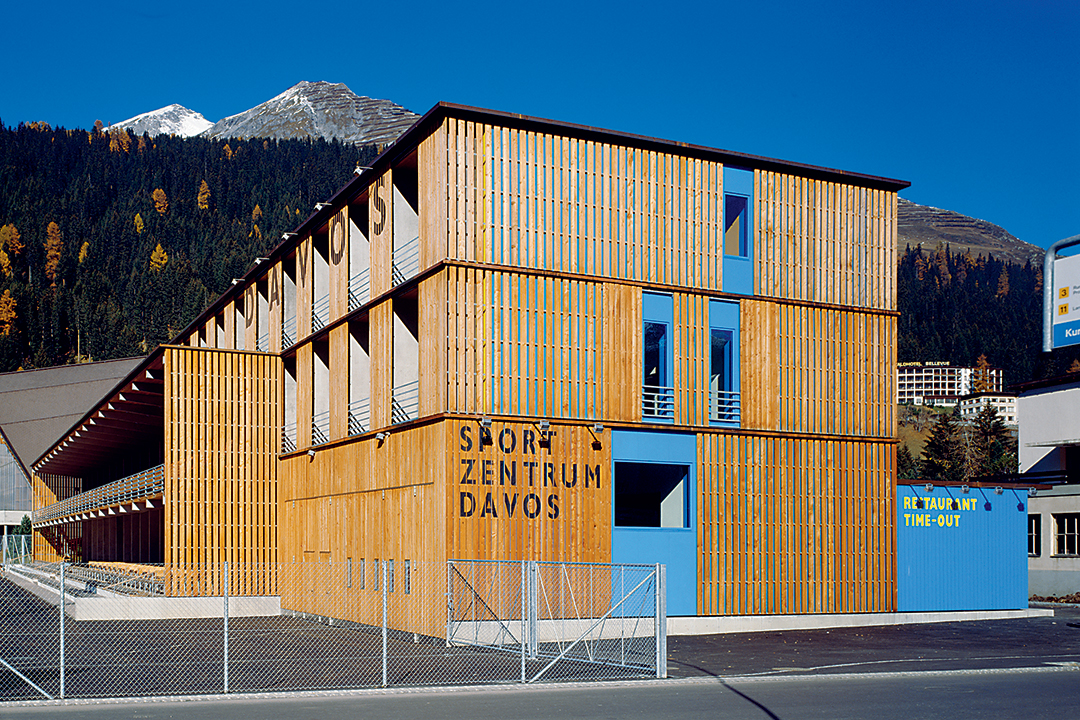
ORIS: When we talk about materiality, we certainly have to speak about colour. There are projects in which you quite deliberately use a certain colour, like for example in the sports centre in Davos, in the Zürich University auditorium, in residential buildings where you work with material that is in fact unacceptable, with external insulation. These cube volumes are divided into differently painted surfaces that are connected, so this perception of a cube partially disappears. What is the meaning of this colouristic concept?
Gigon: We indeed use colour in various ways. In case of Römerholz in Winterthur, we used the colour very conceptually, related to the colour tone, as well as the materiality of colour as such. There is also the other example with the conceptual attitude in regard to colour materiality: the railway switching station in Zürich. There we tried to establish a relationship with railroad tracks, i.e. anticipate the pollution caused by iron particles made by train brakes. We knew that it is standard to colour the concrete with pigments of iron oxide when you want to get yellow, orange or brown tones. We thought about whether to apply the paint only from the outside, so to speak as a pollution made because of iron particles, or by painting the entire concrete material with the method of ‘injection’ so to say. We decided for the latter. For the railway switching station we invited artist Harald F. Müller to work with us, and in Römerholz we experimented on our own.
In the case of the sports centre, we intended to make a building that reflects today’s sports facilities, with multicoloured sports jerseys with numbers on it. With application of colour we wanted to create some sort of ‘permanent liveliness’ of that building.
In residential buildings, the reasons for the application or absence of colour were different. One of the reasons was truly the method of construction with the external plastered insulation. We reacted by stretching the plaster-like skin, and did not give it any typical mineral colour, white, beige or grey. In order to indicate that there is ‘organic’ material under the plaster (carbon based – expanded polystyrol), we used a brown tone we can find in organic materials like wood, leather, humus. With the windows we tried to express the luxury of the view of the landscape, park and lake, so we developed conspicuously framed windows, that ‘consume’ the view as though they are ‘eyes’.
However, we painted three concrete residential buildings – three houses in Susenbergstrasse on Zürichberg (collaboration with Adrian Schiess) and three residential buildings in Wädenswil (collaboration with Pierre André Ferrand). In both cases it was our intent to differentiate the volume, individualize, to eliminate the settlement aspects. In the Pflegi residential building in Zürich (collaboration with Adrian Schiess) we painted individual surfaces in order to create a particular atmosphere in external spaces, when we wouldn’t have been able to achieve this with the colours of construction materials. This also goes for the residential building in Brunnenhof (collaboration with Adrian Schiess), where we used iridescent coloured glass.
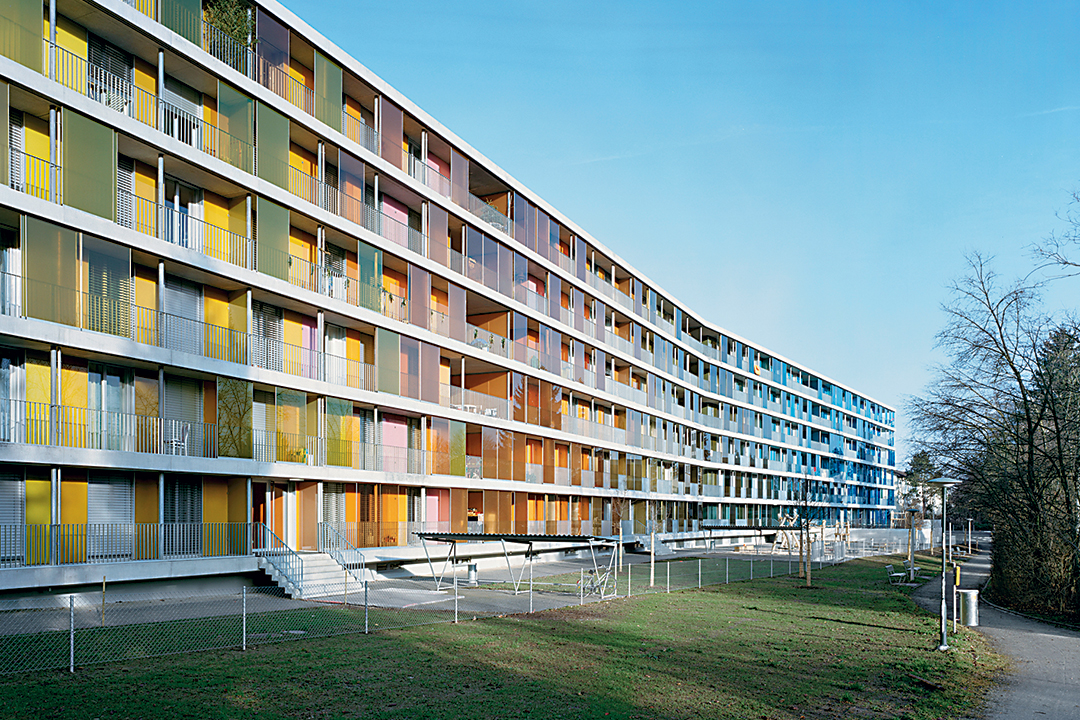
ORIS: You said that the programme is a decisive element in your work. Your Kalkriese archeological park has a very narrative topic – the battle of Romans and Germanic tribes in the early 1st century AD. But there is nothing narrative in your design, it is completely abstract. How did you treat this subject?
I have another question in regard to that project. In some of the pavilions in the park, the perception of event location is reduced to a single meaning. Even in other projects you get the impression that particular moments are left out in favour of making the perception of a particular aspect more sensible. Does the reduction of particular stimuli have any role in your projects?
Gigon: The background of this project is the archaeology of a battle, the Hermann Battle, also known as the Varus Battle [Battle of Teutoburg Forest]. Unlike other archaeological sites, with nicely lined graves or building foundations, here we have coins, lead balls, nails from the shoes, a mask and always the bones, strewn all over the place. The only so-called ‘architectural’ evidence indicates that there was once an earth fortification with palisades. That terrain was examined archeologically, but only partially excavated. Namely, the starting point in archaeology is that in the future there will be other methods of securing findings and of their interpretation. All locations on which there were excavations have been lost for new archaeological findings. There will be future excavations there. In other words, the history of that battle cannot be definitively told. Contrary to everything figurative stands the abstraction open to corrections, realizations and ‘vagueness’, that will always be present. The investor wanted a museum building to exhibit archaeological findings, while the curator wanted pavilions in the field, in order to better explain the historical events to visitors and present them in situ. Instead of narrative, small museum rooms on the former battlefield, in collaboration with designer Lars Müller we created pavilions of ‘singularized’ sensations, with camera obscura as the eye and ear horn as the ear, and monitors showing breaking news from the war.
In order to keep the works on the archeologically valuable terrain as non-invasive as possible, the interventions were kept to the minimum. We used elements and plants from modern agriculture, so there are now meadows and forest like before our intervention. Only one area was excluded, and on it we exceptionally undertook the ‘reconstruction’ of the landscape. Only in that place we excavated the historical level of the terrain, re-established the swampy landscape and reconstructed a German fortification.
Still, we can say that these minimum construction measures play the role of staging. The rusting steel speaks of the temporal dimension, transiency, but it is still anchored in our industrial epoch, making today’s intervention readable. We walk on the large steel plates laid on the meadow, on the former battlefield. They remind one of provisional bridging of construction pits at construction sites, but also of shields or tombstones. We go from plate to plate and ‘collect’ information and knowledge from individual signs – like an archaeologist, ‘collect’ information from the floor, fragmented like splinters.
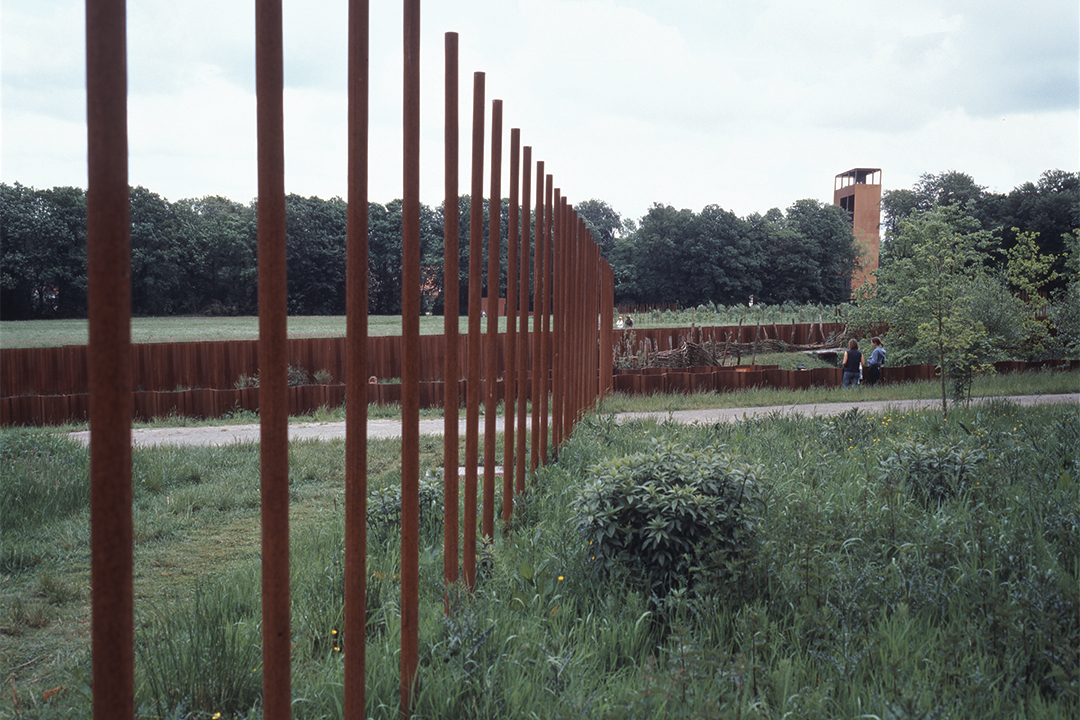
ORIS: One question concerning your somewhat recent project, the Prime Tower in Maag Areal in Zürich. Will your first business building be the tallest building in Zürich? It is located in the industrial zone that in the past 15 years has been filled with new housing, cinema, theatre constructions. How does the relationship to industrial context function?
Gigon: Thirty years ago, this district was one of the least pleasant city areas – behind fences and factories lay ‘forbidden cities’, a no-man’s land with no rights of access. With the departure of industry some twenty years ago, these areas became successively more open. Artists, graphic designers and architects moved there and we did as well. Organization of events, parties, musicals in the former industrial halls attracted a large audience to this district. Development from industrial area into a new part of the city was a long-term process that was followed by planning on behalf of the city authorities. Discussions, workshops, zoning competitions meant gradual evaluation of the industrial buildings and decisions on which of them should be preserved, where new buildings should be built and how high should they be. When we took part in an invited competition, these things were already fixed. But this mixture of the existing and newly-built seemed promising to us. The thing that I believe will give Prime Tower its accent is not so much its height, but its position at the crossroads of Hardbrücke and the railway tracks. We believe that locating the skyscraper near the railway station will not be only a sign of the change of the former industrial area into urban tissue, but also a sign of future visibility and presence of the new town area.
ORIS: We have one question related to teaching architecture. From 2001 to 2002 you were guest professor at the EPFL in Lausanne, and since 2008 you’re guest professor at ETH Zürich. We’re actually interested in your concept of teaching architecture. What do you actually want to convey to your students?
Gigon: It’s a difficult question and I am currently asking myself the same thing. I realized that teaching gives me great pleasure, that it feels very good working with students, when I teach them things I discovered for myself, when I can motivate them but also allow for doubts – at the same time having the opportunity to find out a few things myself.